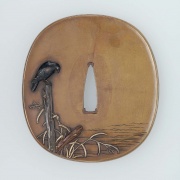Shakudo
Jump to navigation
Jump to search
Description
A traditional Japanese surface colored copper alloy made since the 15th century. Shakudo contains Copper (75-98%) and Gold (2-25%, but most commonly 3-5%). Traces of other metals (Silver, Arsenic, Tin, Lead, Antimony, or Iron) may also be present. Shakudo is used for jewelry, tsubas, and sword decoration. Various patination formulas are used to produce a range of colors. The most common is a blue-black.
Synonyms and Related Terms
shaku-do (Jap.)
Resources and Citations
- Reactive Metals Studio: Data sheet: Shakudo and Shibuichi
- B. Sueters, 'Tsuba, their manufacturers and techniques' Andon v. 65, p. 18, 2000.
- R. Murakami, 'Japanese traditional alloys' in Metal Plating and Patination, eds. S. La Niece and P. Craddock, Butterworth Heineman, 1993.
- H. Ogucki, 'Japanese Shakudo. Its History, Properties and Production from Gold-Containing alloys' in Gold Bulletin, v. 16 (4), p. 125-132, 1983. Link
- G.S.Brady, Materials Handbook, McGraw-Hill Book Co., New York, 1971 Comment: p. 657
- David C. Scott, Metallography and Microstructure of Ancient and Historic Metals, The Getty Conservation Institute, Los Angeles, 1991
- Wikipedia: http://en.wikipedia.org/wiki/Shakudo (Accessed Nov. 9, 2005)
